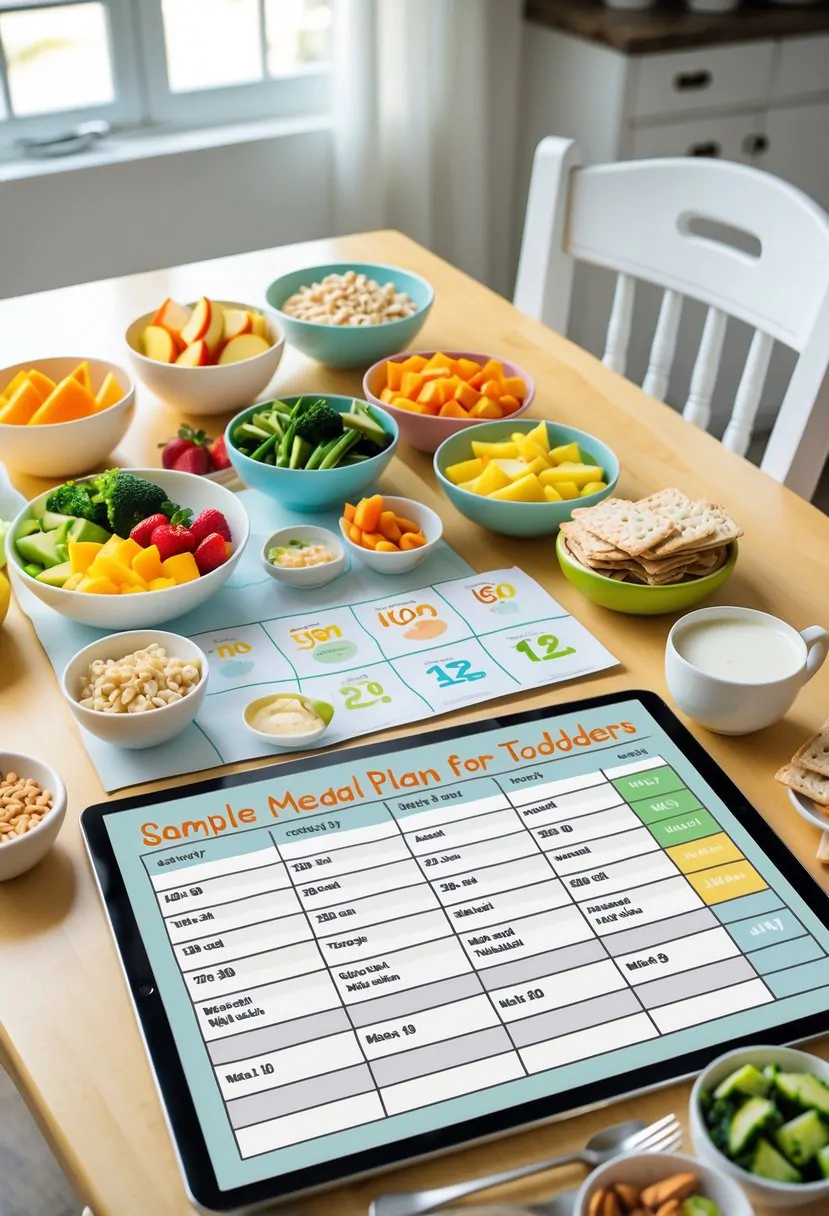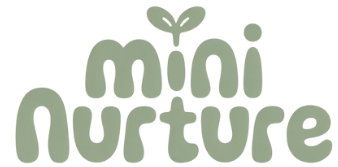Creating a meal plan for toddlers helps parents provide balanced nutrition that supports growth and development. A well-rounded toddler meal plan includes a mix of vegetables, fruits, grains, proteins, and dairy to meet daily calorie and nutrient needs.
Planning meals ahead makes feeding less stressful and ensures toddlers get the variety they need to build healthy eating habits.

Toddlers typically need three meals and one or two snacks each day, with portions sized for their smaller appetites. Offering finger foods and familiar favorites alongside new options encourages independence and curiosity about eating.
Staying consistent with meal times and including the whole family can make mealtimes smoother and more enjoyable. Careful planning also allows parents to adjust meals to fit their toddler’s preferences and activity level while avoiding common mealtime struggles.
Practical tips and easy recipes make it easier to serve nutritious meals without extra hassle or stress. More details and sample meal ideas can provide helpful guidance for parents looking to get started.
Key Takeaways
- Balanced meals help toddlers get essential nutrients for growth.
- Regular meal and snack times support good eating habits.
- Simple planning and easy recipes reduce mealtime stress.
Foundations of a Healthy Toddler Meal Plan

A healthy toddler meal plan depends on providing the right nutrients, organizing meals effectively, and choosing natural, wholesome ingredients. These factors work together to support growth, energy, and good eating habits.
Careful planning ensures toddlers get balanced meals with variety in flavors and textures.
Key Nutrients for Toddlers
Toddlers need a mix of macronutrients: carbohydrates, proteins, and healthy fats. Carbohydrates give energy for active play and growth.
Whole grains like brown rice, oats, and whole wheat bread provide steady energy and fiber. Protein supports muscle and tissue growth.
Good sources include lean meats, eggs, beans, and lentils. Healthy fats are important for brain development and hormone production.
Foods with healthy fats include avocados, nut butters, and olive oil. Vitamins and minerals, especially calcium and iron, are vital.
Dairy or fortified plant milk offers calcium for strong bones. Iron-rich foods like meat, beans, and fortified cereals help avoid anemia.
Including fruits and vegetables supplies important vitamins like vitamin C, which also helps iron absorption.
Daily Meal Structure and Schedule
Toddlers benefit from three main meals and two to three snacks spread evenly throughout the day. This schedule helps prevent hunger and keeps energy steady.
Typical meal times might include:
- Breakfast
- Morning snack
- Lunch
- Afternoon snack
- Dinner
Meals should be balanced and portioned small, as toddlers have small stomachs. Snacks should be nutrient-rich, such as yogurt with berries, whole grain crackers, or fruit slices with peanut butter.
Hydration is important too; water and milk are preferred fluids, while sugary drinks should be limited.
Choosing Whole Foods and Healthy Ingredients
A toddler meal plan centered on whole foods avoids heavily processed items. Whole grains like brown rice, whole wheat pasta, and oats offer more fiber and nutrients than refined grains.
Fresh fruits and vegetables add color, variety, and important nutrients. It’s best to include a mix of colors throughout the week to make meals appealing and provide a range of vitamins.
Healthy fats from natural sources help support brain growth. Avoid foods high in added sugars or salt.
Preparing meals with fresh ingredients and simple cooking methods also helps maintain nutrient quality. This approach builds good eating habits while ensuring proper nutrition.
For more detailed guidance, see a balanced toddler meal plan.
Sample Meal Plans and Scheduling

Toddlers need meals that include variety, nutrition, and consistent timing to support healthy growth. A good approach balances proteins, carbs, fats, and produce while allowing flexibility for appetite changes and taste preferences.
Meal timing helps toddlers develop a routine and stay hungry for meals.
Balanced Daily Meal Example
A typical toddler day includes three main meals and two snacks spaced about 2-3 hours apart. For example:
- Breakfast: Applesauce waffles with nut butter and a side of fruit
- Morning Snack: Banana and water
- Lunch: Spinach pesto pasta, grapes, and milk
- Afternoon Snack: Cherry tomatoes and raisins
- Dinner: Cheesy meat bun, broccoli, and milk
This plan offers protein from meat and dairy, complex carbs in whole grains and veggies, healthy fats from nut butter, and fruit for vitamins and fiber. Serving milk twice helps with calcium and hydration.
Meals are simple and varied to keep the toddler interested.
Weekly Toddler Meal Plan Ideas
A weekly toddler meal plan can rotate familiar foods to build consistency while introducing new items gradually. For example, oatmeal or spinach pancakes can be breakfast staples two or three times a week.
Lunches might alternate between grilled cheese with sweet potato fries, bean quesadillas, or soups with veggie sides. Snacks should include easy, nutrient-rich options like cheese sticks, yogurt, fruit slices, or homemade crackers.
Planning snacks as mini meals with some protein and fruit or veggie can improve mealtime cooperation. Repeating meals on different days helps toddlers get used to food, reducing pickiness over time.
Keeping the weekly plan flexible allows parents to adapt to their child’s hunger and preferences.
Flexible Approaches for Picky Eaters
Toddlers often have picky phases, and flexibility in meal planning can reduce stress for both parent and child. Parents can serve small portions of several foods and let toddlers pick what and how much to eat.
Including familiar favorites alongside new foods encourages trying different tastes without pressure. For example, serving a cheese quesadilla with some new vegetable sticks on the side lets the child gradually accept new foods.
Offering snacks before meals or a small snack later in the day can help if the toddler has varying hunger patterns. Avoiding grazing all day helps maintain appetite for regular meals.
Keeping meal and snack times consistent while adjusting portions supports healthy eating habits even during selective eating phases.
Easy and Nutritious Toddler Meal Ideas

Toddlers need meals that are quick to prepare, balanced, and appealing in taste and texture. Meals that mix fruits, vegetables, protein, and whole grains help meet their growing needs while keeping them interested in eating.
Breakfast Options
Breakfasts for toddlers should be simple, filling, and packed with nutrients like fiber and protein. A popular choice is banana oatmeal, which combines fruit sweetness with whole grains.
It can be made in under 10 minutes and offers energy for the morning. Other good options include:
- Scrambled eggs with veggies
- Whole grain toast with almond butter and fruit
- Yogurt mixed with berries and a sprinkle of hemp seeds
Freezer-friendly choices like spinach waffles or pancake muffins save time for busy mornings. These meals support growth and keep toddlers energized until lunch.
Lunch Favorites
Lunch should offer a variety of textures and flavors while being easy to eat. Mini bagel pizzas topped with colorful veggies are a fun way to include vitamins and encourage eating.
Other strong lunch picks feature:
- Turkey and carrot roll-ups
- Veggie-loaded quesadillas
- Avocado tuna salad served in mini pita pockets
Using leftovers like baked chicken tenders makes lunch prep faster and ensures toddlers get protein for muscle growth. Balance includes fruits, vegetables, grains, and protein to keep energy steady throughout the day.
Dinners for the Whole Family
Dinners that work for toddlers and adults are usually simple, nutritious, and adaptable in portion size. Recipes like baked chicken tenders can be made quickly and served with steamed vegetables and whole grains like brown rice or quinoa.
Easy family dinners include:
- Garlic broccoli pasta
- Cheesy egg muffins with broccoli
- One-pot veggie pasta
These meals provide protein, fiber, and healthy fats, meeting toddler dietary needs while offering meal variety. Preparing larger portions helps with leftovers, saving time on following days.
Healthy Snacks for Toddlers
Snacks should be nutrient-dense and easy to eat on the go. Great choices are wholesome granola bars, yogurt pouches, and fruit-filled muffins like blueberry avocado mini muffins.
Other snack ideas:
- Carrot hummus with pita chips
- Mini energy balls made with oats and nuts
- Cinnamon applesauce
Offering snacks with fruits, vegetables, and some protein helps fill nutritional gaps and keeps toddlers satisfied between meals. Many snacks can be frozen or made ahead of time to simplify busy days.
Find more balanced toddler meal ideas at Baby Foode’s 75 Toddler Meals.
Practical Tips for Toddler Mealtimes

Toddlers benefit from clear mealtime routines that include trying new foods, safe food preparation, and positive family dining habits. Consistent snacks and meals with balanced nutrition help build healthy eating patterns early.
Parents should focus on offering variety, managing portion sizes, and creating a calm mealtime environment to encourage good behavior and enjoyment.
Encouraging Variety and Trying New Foods
Introducing different foods helps toddlers develop a taste for healthy options like whole grains and healthy fats. Parents can serve small portions of new items alongside familiar favorites to make tasting less intimidating.
Repeated exposure is key; it may take 10-15 tries before a toddler accepts a new food. Offering foods in various textures encourages sensory exploration.
For example, soft cooked vegetables alongside crunchy whole grain crackers provides contrast. Using colorful plates or fun shapes can make food more appealing.
Avoid pressuring the child to eat; instead, praise any willingness to try. This builds a positive attitude toward food.
Modeling healthy eating by adults also influences toddlers to explore new flavors more willingly.
Safe Food Preparation and Portioning
Safety during mealtime is essential. Toddlers should sit securely in a high chair or booster seat with straps for proper support.
Foods need to be cut into small, manageable pieces to prevent choking. Avoid hard, round, or sticky foods that pose risks.
Serving appropriate portion sizes helps toddlers regulate their hunger and fullness cues. Parents can use small plates or bowls to avoid overwhelming the child.
Typical toddler portions are about a quarter of an adult serving, focusing on balanced groups like fruits, vegetables, protein, healthy fats, and whole grains.
Using unbreakable dishes with smooth edges reduces accidents. Washing hands before eating and cleaning surfaces keeps the mealtime area hygienic.
Safe food handling also means cooking foods thoroughly and storing leftovers properly.
Promoting Family Meals and Positive Habits
Eating together encourages social skills and healthy habits. Family meals provide a chance for toddlers to learn by watching adults eat balanced meals that include whole grains and healthy fats.
Sitting at the table without screens or distractions keeps attention on food and conversation. Keeping mealtimes consistent with set times supports a toddler’s internal hunger clock.
Short meals, about 10–15 minutes, work best since attention spans are limited. Engaging toddlers in conversation during meals helps develop language and connection.
Allowing toddlers to choose how much to eat respects their appetite signals. This reduces food battles and promotes self-regulation.
Positive mealtime environments encourage a lifelong healthy relationship with food.
Frequently Asked Questions

Toddlers need a mix of nutrients every day to support their growth and development. A balanced meal plan includes a variety of foods from all the food groups in the right portions.
Snacking can also help meet their energy needs without overeating.
What are the nutritional requirements for toddlers aged 1-3 years?
Toddlers need carbohydrates, proteins, fats, vitamins, and minerals. They should eat fruits, vegetables, whole grains, dairy, and protein-rich foods like meat, fish, eggs, or beans.
Calcium and iron are especially important during this stage.
How can I create a balanced weekly meal plan for my 2-year-old?
Include starchy foods like rice or bread at each meal. Add a variety of fruits and vegetables daily.
Offer dairy products three times a day and protein foods two to three times. See a detailed guide on planning meals for toddlers.
What foods should I include in a meal plan for a toddler to promote weight gain?
Choose nutrient-dense foods like full-fat yogurt, cheese, nut butters, and avocado. Include healthy fats and protein at meals and snacks.
Small, frequent meals with energy-rich foods support healthy weight gain.
Can you suggest a diverse meal plan for a 3-year-old toddler?
Offer a mix of grains, dairy, fruits, vegetables, and proteins every day. Vary sources of protein with meat, fish, eggs, or legumes.
Include different colors and textures to encourage trying new foods.
What are some healthy snack options for a 1-year-old baby?
Soft fruits like banana slices, cooked vegetables, cheese cubes, and whole grain crackers work well. Yogurt and mild nut butters (spread thinly) are also good choices.
Snacks should be easy to eat and nutrient-rich.
How much food should a 2-year-old eat at each meal?
Portions are small because toddlers have small stomachs. A good rule is 1/4 to 1/2 of an adult portion.
Use toddler-sized plates and utensils to help with portion control. Serving sizes vary daily depending on appetite and growth needs.

